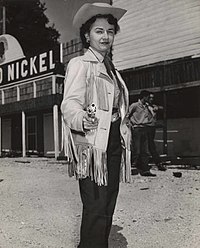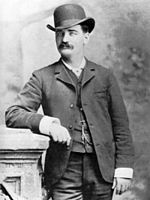Wrangler Western Fashion Snap Shirts Rn 130273 Ca 55394 Wrangler Western Fashion Snap Shirts

Adult female wearing fringe jacket and lid, USA, 1953
Western vesture is a category of men's and women'south habiliment which derives its unique style from the apparel worn in the 19th century Wild West. It ranges from accurate historical reproductions of American borderland vesture, to the stylized garments popularized by Western film and television or singing cowboys such as Gene Autry and Roy Rogers in the 1940s and 1950s. Information technology continues to be a manner choice in the Westward and Southwestern United states, as well as people associated with country music or Western lifestyles, for example the various Western or Regional Mexican music styles. Western wear typically incorporates 1 or more of the following, Western shirts with pearl snap fasteners and vaquero design accents, blue jeans, cowboy chapeau, a leather belt, and cowboy boots.
Chapeau [edit]

In the early days of the Old Westward, it was the bowler hat rather than the slouch hat, centercrease (derived from the army regulation Hardee hat), or sombrero that was the nearly pop amidst cowboys every bit it was less likely to blow out off in the wind.[i] By the 1870s, nonetheless, the Stetson had become the well-nigh popular cowboy hat due to its use by the Union Cavalry as an alternative to the regulation blue kepi.[2] [3]
Stampede strings were installed to forbid the hat from being blown off when riding at speed. These long strings were usually made from leather or horsehair. Typically, the string was run half-way around the crown of a cowboy hat, and and then through a hole on each side with its ends knotted and and then secured nether the chin or around the back of the head keeping the hat in place in windy conditions or when riding a horse.
The tall white ten gallon hats traditionally worn past motion-picture show cowboys were of little use for the historical gunslinger as they made him an piece of cake target, hence the preference of lawmen like Wild Pecker Hickok, Wyatt Earp and Bat Masterson for low-crowned black hats.[4]
Originally part of the traditional Plains Indian clothing, coonskin caps were frequently worn past mountain men like Davy Crockett for their warmth and durability. These were revived in the 1950s following the release of a pop Disney movie starring Fess Parker.[5] [6]
Shirt [edit]

A Western shirt is a traditional item of Western clothing[7] characterized past a stylized yoke on the front and on the back. Information technology is by and large constructed of chambray, denim or tartan material with long sleeves, and in modern form is sometimes seen with snap pockets, patches made from bandana fabric, and fringe. The "Wild West" era was during the tardily Victorian era, hence the direct similarity of fashion.
A Western wearing apparel shirt is often elaborately decorated with piping, embroidered roses and a contrasting yoke. In the 1950s these were frequently worn past picture cowboys like Roy Rogers or Clayton Moore's Lone Ranger.[viii] Derived from the elaborate Mexican vaquero costumes like the guayabera, these were worn at rodeos and so the cowboy could be easily identifiable.[ix] Buffalo Pecker was known to wear them with a buckskin fringe jacket during his Wild West shows and they were fashionable for teenagers in the 1970s and late 2000s.[10]
Another common type of Western shirt is the shield-front shirt worn past many US Cavalry troopers during the American Civil War simply originally derived from a blood-red shirt issued to prewar firefighters. The cavalry shirt was made of blue wool with yellowish piping and brass buttons and was invented past the flamboyant George Armstrong Custer.[eleven] In recent times this shield-front shirt was popularised by John Wayne in Fort Apache and was besides worn by rockabilly musicians similar the Stray Cats.
In 1946, Papa Jack Wilde put snap buttons on the front, and pocket flaps on the Western shirt, and established Rockmount Ranch Wear.
Coat [edit]
When a jacket is required in that location is a wide choice bachelor for both linedancers and historical re-enactors. These include frock coats, ponchos popularised by Clint Eastwood's Spaghetti Westerns, short Mexican jackets with argent embroidery, fringe jackets popular amidst outlaw land, southern stone and 1980s heavy metal bands,[12] and duster coats derived from originals worn in the Wild W.[13] More than modernistic interpretations include leather waistcoats inspired past the biker subculture and jackets with a design imitating the piebald color of a cow. Women may vesture bolero jackets derived from the Civil State of war era zouave uniforms, shawls, denim jackets in a color matching their skirt or dress, or a fringe jacket like Annie Oakley.[14]
For more formal occasions inhabitants of the Due west might opt for a suit with "smile" pockets, pipe and a yoke similar to that on the Western shirts. This can take the course of an Ike jacket, leisure suit or three-button sportcoat. Country and Western vocalist Johnny Cash was known to article of clothing an all-black Western adapt, in contrast to the elaborate Nudie suits worn by stars like Elvis Presley and Porter Wagoner.[fifteen] The most elaborate western wear is the custom work created by rodeo tailors such equally Nudie Cohn and Manuel, which is characterized by elaborate embroidery and rhinestone decoration. This type of western wearable, popularized past country music performers, is the origin of the phrase rhinestone cowboy.
Trousers [edit]


In the early days of the Wild West trousers were made out of wool. In summer sheet was sometimes used. This changed during the Golden Rush of the 1840s when denim overalls became pop amidst miners for their cheapness and breathability. Levi Strauss improved the design by adding copper rivets[xvi] and by the 1870s this design was adopted past ranchers and cowboys.[17] The original Levi'south jeans were presently followed by other makers including Wrangler jeans[xviii] and Lee Cooper. These were oftentimes accessorised with kippy belts featuring metal conchos and large belt buckles.
Leather chaps [pronounced /šæps by existent cowboys] were oftentimes worn to protect the cowboy'southward legs from cactus spines and prevent the cloth from wearing out.[xix] Two common types include the skintight shotgun chaps[20] and wide batwing chaps. The latter were sometimes fabricated from hides retaining their hair (known as "woolies") rather than tanned leather. They appeared on the Dandy Plains somewhere around 1887.[21]
Women wore human knee-length prairie skirts,[22] red or blueish gingham dresses or suede fringed skirts derived from Native American dress. Saloon girls wore short red dresses with corsets, garter belts and stockings.[23] After World State of war Ii, many women, returning to the abode after working in the fields or factories while the men were overseas, began to wear jeans similar the men.
Neckwear [edit]

Working cowboy wearing a bandana or "wild rag," 1880s
During the Victorian era, gentlemen would habiliment silk cravats or neckties to add color to their otherwise sober black or grey attire. These continued to be worn by respectable Westerners until the early 20th century. Following the Civil State of war it became common practice among working class veterans to loosely tie a bandana around their necks to absorb sweat and keep the dust out of their faces. This practise originated in the Mexican War era army when troops threw away the hated leather stocks (a type of neckband issued to soldiers) and replaced them with cheap paisley kerchiefs.[24]
Another well-known Western accompaniment, the bolo necktie, was a pioneer invention reputedly made from an expensive hatband.[25] This was a favorite for gamblers and was quickly adopted by Mexican charros, together with the slim "Kentucky" manner bowtie commonly seen on stereotypical Southern gentlemen like Colonel Sanders[26] or Boss Hogg. In modern times information technology serves as formal habiliment in many western states, notably Montana, New United mexican states[27] and Texas.[28]
Footwear [edit]
Run into Cowboy kick
Image gallery [edit]
-

Example of the garish Western shirts popular in the 1970s and amid the mod-day indie stone scene
-
-
Accurate Stetsons from the 1880s
-

Modern re-enactors dressed every bit saloon girls
-

Arizona cowboy wearing a "John Wayne" style Western shirt
References [edit]
- ^ The Lid That Won the W , retrieved 2010-02-10
- ^ Stetson Hats 1865–1870, Jeffery B. Snyder 1997
- ^ * CavHooah.com – Stetson Folio
- ^ Wild Pecker Hickok collection[usurped!] at Nebraska State Historical Society
- ^ The Coonskin Cap
- ^ Top of the Craze. 1957 Wales
- ^ "10 Stylish Western Outfits That You Must accept in Your Wardrobe". Buy Clothing Online Britain - Shop All-time Womens & Mens Fashion Clothing . Retrieved 2021-03-22 .
- ^ Western Shirts
- ^ Guayabera
- ^ The Western shirt
- ^ Shield front shirts
- ^ ane. ^ U.Southward. Cavalryman, 1865-1890, past Martin Pegler
- ^ # George-Warren, Holly, and Michelle Freedman: How the West Was Worn, Harry Northward. Abrams (2001), ISBN 0-8109-0615-5.
- ^ "Fiddling Miss Certain Shot" - The Saga of Annie Oakley
- ^ Bristles, Tyler (2001). 100 Years of Western Article of clothing, p. 72. Gibbs Smith, Table salt Lake City. ISBN 0-87905-591-X.
- ^ United states of america 139121, Davis, Jacob, "Comeback in fastening pocket-openings", published 1873-05-xx, assigned to Levi Strauss & Co.
- ^ Transcript, Levi Strauss vs. H.B. Elfelt, District of California Excursion Court of the United States Ninth Judicial Circuit, 1874. National Archives, Pacific Sierra Region
- ^ Official website
- ^ English language schooling chaps. Web folio accessed April 28, 2008
- ^ Cowboyway.com, caption of chaps styles. Spider web folio accessed March ten, 2008
- ^ "Westerners: Wild and Wooly Chaps." Wild West Magazine, February 2007, The History Cyberspace. Archived 2007-09-30 at the Wayback Automobile Web site accessed September ii, 2007
- ^ George-Warren, Holly, and Michelle Freedman: How the W Was Worn, p. 184-187.
- ^ Waugh, Norah (December one, 1990). Corsets and Crinolines. Routledge. ISBN 0-87830-526-2.
- ^ Don Troiani'southward Soldiers in America
- ^ Arte en la Charerria: The Artisanship of Mexican Equestrian Civilisation Archived 2010-01-31 at the Wayback Auto at the National Cowboy & Western Heritage Museum, Oklahoma City
- ^ Pearce, John, The Colonel (1982) ISBN 0-385-18122-1
- ^ "Richardson'south Secret Weapon: The Bolo Necktie". The Washington Post.
- ^ Texas, The Lonely Star State: Bola Tie (Bolo Necktie)
Farther reading [edit]
- Wearing apparel lawmaking (Western)
- Western lifestyle
- Beard, Tyler; Arndt, Jim (1993). 100 Years of Western Wear. Gibbs Smith Publishers. ISBN0-87905-591-X.
- George-Warren, Holly; Freedman, Michelle (2001). How the West Was Worn . Harry N. Abrams. ISBN0-8109-0615-5.


0 Response to "Wrangler Western Fashion Snap Shirts Rn 130273 Ca 55394 Wrangler Western Fashion Snap Shirts"
Post a Comment